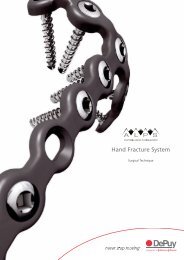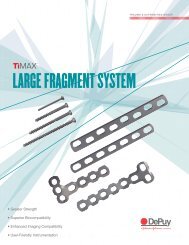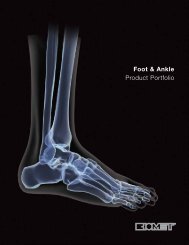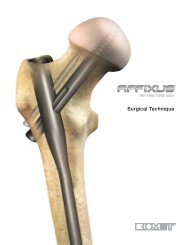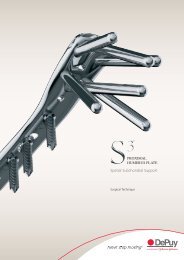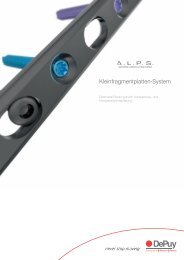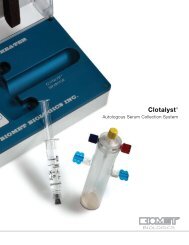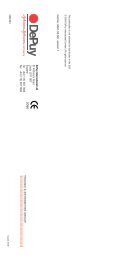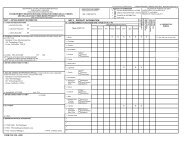VersaNail® Femoral Universal Product Rationale and ... - Biomet
VersaNail® Femoral Universal Product Rationale and ... - Biomet
VersaNail® Femoral Universal Product Rationale and ... - Biomet
Create successful ePaper yourself
Turn your PDF publications into a flip-book with our unique Google optimized e-Paper software.
VersaNail ®Securing optimal fixationthrough versatile locked <strong>and</strong>compression plating technology<strong>Femoral</strong> <strong>Universal</strong><strong>Product</strong> <strong>Rationale</strong><strong>and</strong> Surgical Technique
VersaNail ®<strong>Femoral</strong> <strong>Universal</strong>ContentsDesign Summary.........................................................................................................................................................3Implant Overview.........................................................................................................................................................4Antegrade Entry <strong>and</strong> Canal Preparation.......................................................................................................................6Antegrade Nail Insertion.............................................................................................................................................10Antegrade Locking....................................................................................................................................................13Retrograde Entry <strong>and</strong> Canal Preparation....................................................................................................................20Retrograde Nail Insertion...........................................................................................................................................24Retrograde Locking...................................................................................................................................................29End Cap Placement <strong>and</strong> Nail Removal......................................................................................................................35Ordering Information..................................................................................................................................................38Flexible Reaming System...........................................................................................................................................42Note: This brochure presents a surgical technique available for use with the <strong>Biomet</strong> VersaNail ® Platform instruments <strong>and</strong> implants. Surgeons may need to make modificationsas appropriate in their own surgical technique with these devices depending on individual patient requirements.1
VersaNail ®<strong>Femoral</strong> <strong>Universal</strong>One Implant Designed for the Efficient Treatment of aRange of Femur Fractures• Anatomically designed for treatment of both antegrade<strong>and</strong> retrograde applications• The intuitive, universal instrumentation system enablesefficiency in the OR• <strong>Universal</strong> design to aid inventory managementThe VersaNail ®<strong>Femoral</strong> <strong>Universal</strong> Nail is part of a long bone nailingsystem that offers a complete portfolio of implants <strong>and</strong> instrumentsbased on a single, st<strong>and</strong>ardized technology platform. The <strong>Femoral</strong><strong>Universal</strong> Nail System from the VersaNail Platform offers options to treata range of femoral fractures using either an antegrade or retrogradeapproach with one implant. The VersaNail Platform instrumentationsystem is designed for intuitive assembly <strong>and</strong> ease-of-use by OR staff<strong>and</strong> surgeons, enabling a simpler <strong>and</strong> more efficient procedure. Theinstrumentation is designed to provide intra-operative options includingentry portals, reduction tools <strong>and</strong> color-coded screw placement, whilebeing st<strong>and</strong>ardized to maintain commonality across the platform.3
VersaNail ®<strong>Femoral</strong> <strong>Universal</strong>The <strong>Femoral</strong> <strong>Universal</strong> Nail is designed to treat:• <strong>Femoral</strong> shaft fractures• Proximal or mid-shaft femoral non-unions <strong>and</strong>malunions• Pathologic fractures in osteoporotic bone of the diaphyseal area• Revision procedures<strong>Universal</strong> design allows one nail for eitherantegrade or retrograde application to treatright- or left-sided fractures.Enlarged nail cannulation accepts the ball noseguide wire, eliminating the need for an exchangetube.2.2 meter radius of curvature accommodatesthe anterior bow of the femur.Large core diameter of 4.5 mm non-drive end screwsdecreases the risk of screw breakage.Distal locking options to treat a greater range offracture patterns.Bullet-style tip increases ease of insertion.5 mm Dynamization option allows compression atthe fracture site.The VersaNail Platform instrumentation system is designed to be intuitive, enabling a simpler <strong>and</strong> more efficient procedure. The VersaNailPlatform’s modular nature facilitates the use of common instruments across all VersaNail nailing systems, reducing confusion among theOR staff. For example, VersaNail Platform jigs look <strong>and</strong> function the same way, <strong>and</strong> common instruments (such as awls, entry portals,guide wires, nail length gauge, locking instrumentation <strong>and</strong> screw caddies) can be used across all VersaNail Platform nailing systems.4
12 mm Drive End Diameterfor 9-12 mm Nails0 mmDrive End DiameterEqual to Nail Diameterfor 13-15 mm Nails14 mm64 mm29 mm39 mm54 mm10 mmDymanizationRange12 mm drive end accommodates 6.5 mm screws.Large core diameter of 6.5 mm screws decreasesrisk for screw breakage.10 mm Dynamization option allows compressionat the fracture site.48 mm38 mm28 mm18 mm13 mm0 mm5 mmDymanizationRangeMultiple locking options for optimum implant stabilityThe <strong>Femoral</strong> <strong>Universal</strong> Nail hole configurations provide a number of locking possibilities.The <strong>Femoral</strong> <strong>Universal</strong> Nail is locked with 6.5 mm screws on the drive end <strong>and</strong> 4.5 mm screws on the non-drive end.The locking instrumentation is color-coded for ease of use:Color Screw Size Drill Bit SizeBlack 6.5 mm Cortical 5.3 mmGold 6.5 mm Cancellous 6.5 mm/4.8 mm Step DrillSilver 3.2 mm Guide Pin SleeveGreen 4.5 mm Cortical 3.8 mm5
VersaNail ®<strong>Femoral</strong> <strong>Universal</strong>Antegrade Entry <strong>and</strong> Canal PreparationFigure 1 Figure 2Patient PositioningPlace the patient in the supine position on a fracture orradiolucent imaging table (Figure 1). Lateral access to theproximal femur is required. The affected leg must beadducted <strong>and</strong> the trunk secured <strong>and</strong> bent toward theopposite side. The contralateral leg may be flexed at the hipor scissored below the affected leg.Entry Site <strong>and</strong> Surgical ApproachIdentify the entry site, which is in the piriformis fossa. Theideal entry point is adjacent to the greater trochanter at thelateral edge of the piriformis fossa.Initiate the entry site with a 3.2 mm guide pin through a stabincision proximal to the trochanteric region, in line with thefemoral axis. Confirm correct entry location <strong>and</strong> guide pinplacement radio-graphically with A/P <strong>and</strong> lateral views(Figure 2). The guide pin placement should be in line withthe center of the femoral canal in both views.6
Figure 3 Figure 4Once the ideal entry point has been achieved, anappropriate incision can be made. Extend the entry incision1-2 cm (Figure 3).The Entry Portal Sheath (2810-13-005) <strong>and</strong> Trocar (2810-13-004) can be advanced over the guide pin down tothe piriformis fossa. Parallel guide holes allow for accurateadjustment of pin positioning. Remove the trocar from theentry portal, keeping the guide pin in place.The entry portalsheath may be left in place to protect soft tissues duringcanal entry <strong>and</strong> reaming (Figure 4).7
VersaNail ®<strong>Femoral</strong> <strong>Universal</strong>Antegrade Entry <strong>and</strong> Canal PreparationFigure 5 Figure 6Figure 7Entry Site <strong>and</strong> Surgical Approach(cont.)Canal access can be obtained using either a CannulatedEntry Reamer or Cannulated Awl (2810-01-005). Both12 mm (2810-13-001) <strong>and</strong> 13 mm (2810-13-002) entryreamers are available depending on surgeon preference.The proximal nail diameter is 12 mm for all nail sizesequal to or less than 12 mm, <strong>and</strong> 13 mm to 15 mm nailshave a proximal diameter equal to the nail diameter. UseA/P <strong>and</strong> lateral fluoroscopic views to confirm accurateplacement (Figures 5 <strong>and</strong> 6). Use the awl or entry reamerto open the proximal femur in the piriformis fossa.Once access to the femoral canal has been gained, placethe ball nose guide wire into the entry site utilizing thepistol-style Guide Wire Gripper (2810-01-001) (Figure 7). Ifpreferred, a T-h<strong>and</strong>le Guide Wire Gripper (2810-01-002) isalso available as an option.Note: If utilizing the cannulated entry reamer, thelength of the distal portion of the reamer is enlarged<strong>and</strong> matches the length of the drive end portion of thenail. Fluoroscopically verify the entry reamer has beeninserted to the proper depth that will correspond withthe depth of the nail.8
Figure 8Figure 9Fracture ReductionOnce access to the femoral canal has been gained, obtainappropriate anatomic reduction in order to restore length,alignment <strong>and</strong> rotation of the injured limb. Reduction can beachieved through the surgeon’s preferred method such astraction <strong>and</strong>/or an external fixator. To aid in manipulatingthe fracture fragments <strong>and</strong> passing the Ball Nose Guidewire, large (7.5 mm diameter, 2810-01-007) <strong>and</strong> small(6.5 mm diameter, 2810-01-008) reduction tools areavailable (Figure 8).Insert the reduction tool into the medullary canal, past thefracture site. Once the fracture is aligned, pass the BallNose Guide Wire, available in both 80 cm (2810-01-080)<strong>and</strong> 100 cm (2810-01-100) lengths, across the fracturesite. Remove the reduction tool.Canal PreparationAchieve proper alignment of the fracture prior to reaming<strong>and</strong> maintain it throughout the reaming process to avoideccentric reaming. Initiate reaming by placing the VersaNailFlexible Reamers over the 3.0 mm ball nose guide wire(Figure 9). Ream the medullary canal in millimeterincrements until cortical bone is reached <strong>and</strong> half-millimeterincrements thereafter. Surgeon preference should dictatethe actual extent of intramedullary reaming. Monitor thereaming procedure using image intensification to avoideccentric or excessive cortical reaming.9
VersaNail ®<strong>Femoral</strong> <strong>Universal</strong>Antegrade Nail InsertionFigure 10Figure 11Nail Size SelectionAn X-ray template (2810-13-025) including 10 percentmagnification is available to determine nail size preoperatively(Figure 10).Nail Diameter SelectionGenerally, a nail diameter 1 mm to 1.5 mm lessthan the final reamer diameter is chosen. <strong>Femoral</strong><strong>Universal</strong> Nails are available in 1 mm increments from9 mm to 15 mm diameters.Nail Length SelectionWith the tip of the ball nose guide wire at the level of thedesired depth of nail insertion, slide or snap the Nail LengthGauge (2810-01-031) onto the ball nose guide wire untilthe nose contacts the bone, ensuring the tip does not fallinto the existing entry canal, which could result in aninaccurate measurement (Figure 11).10
Figure 12 Figure 13Nail/Jig AssemblyTo obtain the appropriate nail length, read the measurementmark on the nail length gauge that is closest to thebeginning of the black transition area on the guide wire(Figure 12). If a nail of the exact measured length is notavailable, choose a shorter nail of the next closest availablelength. A direct measurement can also be taken of theuninjured extremity using either radiographs withmagnification markers, or directly on the uninjured limb.Place the nail on the femoral insertion h<strong>and</strong>le in thecorrect orientation. The nail should be oriented onthe femoral insertion h<strong>and</strong>le such that the anteriorbow of the nail is in line with the anterior bow ofthe femur <strong>and</strong> the jig is lateral to the nail. Securethe nail to the femoral insertion h<strong>and</strong>le by inserting the<strong>Femoral</strong> Jig Bolt (2810-13-008) through the cannulation ofthe nose <strong>and</strong> tightening with the Jig Bolt Driver (2810-13-006) <strong>and</strong> T-h<strong>and</strong>le (2810-01-004) (Figure 13).11
VersaNail ®<strong>Femoral</strong> <strong>Universal</strong>Antegrade Nail Insertion15 mm5 mmNail/JigJunctionFigure 14 Figure 15Figure 16Nail InsertionOnce proper reduction has been achieved, insert the nailover the 3 mm ball nose guide wire into the medullary canal(Figure 14). It is important not to strike the femoral insertionh<strong>and</strong>le directly.Attach the Hammer Pad (2810-13-011) to the insertionh<strong>and</strong>le (Figure 15). Ensure that the hammer pad is tightenedthoroughly prior to impaction. Avoid excessive force wheninserting the nail. If the nail jams in the medullary canal,extract it <strong>and</strong> choose the next-smaller diameter nail orenlarge the canal appropriately.Note: The femoral insertion h<strong>and</strong>le is marked with threegrooves (Figure 16). The groove closest to the nail is anindicator for the nail/insertion h<strong>and</strong>le junction. A K-wirecan be inserted lateral to medial through the target armif additional identification of the nail/ insertion h<strong>and</strong>lejunction is needed. The middle groove is marked 5 mmfrom the top of the nail <strong>and</strong> the groove farthest from thenail is marked15 mm from the top of the nail. Ensure the nail is seatedto proper depth for planned dynamization.Confirm fracture reduction <strong>and</strong> ensure appropriate nailinsertion depth proximally <strong>and</strong> distally with biplanarfluoroscopy. Remove the ball nose guide wire.12
Antegrade LockingFigure 17DynamizationA dynamic slot has been incorporated in the drive end<strong>and</strong> non-drive end of the nail. The drive end slot has a 10mm range of dynamization. The non-drive end slot has a5 mm range of dynamization. If dynamization is planned,countersink the nail to the appropriate depth to avoidbacking out of the nail into the proximal soft tissues. Lockthe M/L slot in the dynamic mode. Delayed dynamizationmay be performed at a later date with the removal of thestatic screws.<strong>Universal</strong> Target Arm AssemblyAttach the radiolucent <strong>Universal</strong> Target Arm (2810-13-009)onto the insertion h<strong>and</strong>le, using the Target Arm AttachmentBolt (2810-13-026) <strong>and</strong> h<strong>and</strong> tighten (Figure 17). Ensurethe target arm is properly secured to the insertion h<strong>and</strong>lefor excellent targeting.LockingPrior to locking both proximally <strong>and</strong> distally, check femorallength <strong>and</strong> rotational alignment. The nail can be lockedeither distally or proximally first, depending on surgeonpreference.13
VersaNail ®<strong>Femoral</strong> <strong>Universal</strong>Antegrade LockingK-wire (indicator for nail/jig junction)Static Locking HoleSlot - Dynamic ModeSlot - Static ModeStatic Locking ModeFigure 18 Figure 19Figure 20Proximal LockingThe universal target arm is marked to identify which lockingoption is being targeted (Figure 18).Place 6.5 mm cortical locking screws using the blackinstrumentation (Figure 19).Place the 6.5 mm Screw Sheath (2810-13-020) <strong>and</strong> Trocar(2810-13-021) through the appropriate holes in the jig’stargeting arm to locate the incision site (Figure 20). Make astab incision <strong>and</strong> advance the sheath <strong>and</strong> trocar to thebone. Soft tissue dissection should be completed sharp<strong>and</strong> precise to clear a path for the sheath. Undue softtissue tension against the sheath can cause misdirectdrilling.14
Figure 21 Figure 22 Figure 23Note: A 3.2 mm x 17.5 in Guide Pin (9030-03-004) <strong>and</strong>3.2 mm Pin Guide Sleeve (2810-13-018) can be used toverify screw position prior to drilling (Figure 21).Utilizing the 5.3 mm Drill Bit (2810-13-153) drill throughthe drill sleeve <strong>and</strong> sheath until the far cortex is penetrated(Figure 23).Remove the trocar <strong>and</strong> replace it with the 5.3 mm DrillSleeve (2810-13-022) (Figure 22).15
VersaNail ®<strong>Femoral</strong> <strong>Universal</strong>Antegrade LockingFigure 24 Figure 25Proximal Locking (cont.)Read the calibration on the drill bit that lines up with thedrill sleeve to determine the screw length (Figure 24).Ensure the drill sleeve is on bone <strong>and</strong> read the calibrationon the drill bit at the end of the drill sleeve to determinethe appropriate screw length (Figure 24). If penetrating thefar cortex prior to taking the reading, use the screw lengthindicated on the drill bit at the screw depth measurementline. If you are not penetrating the far cortex prior to takingthe reading, add 5 mm in length to the screw lengthreading.If further screw length is required, or if the locking holehas been initiated with a guide pin, a 6.5 mm Screw DepthGauge (2810-13-035) is available to read screw length offof the 3.2 mm x 17.5 in guide pin (Figure 25).16
Figure 26 Figure 27Distal LockingVerify fluoroscopically to assure the proper screw lengthselection. Remove the drill sleeve. Using the 6.5 mmScrewdriver Shaft (2810-13-024), insert the 6.5 mmcortical screw through the sheath. The etch mark on thescrewdriver corresponds with the screw sheath to indicatewhen the screw is fully seated (Figure 26).Place 4.5 mm cortical locking screws using the greeninstrumentation (Figure 27).Use caution as the most proximal screw position could bein femoral neck, depending on the depth of the nail.Repeat above steps for additional screw placement.17
VersaNail ®<strong>Femoral</strong> <strong>Universal</strong>Antegrade LockingFigure 28 Figure 29Distal Locking (cont.)Use fluoroscopy to conduct freeh<strong>and</strong> locking utilizinga familiar freeh<strong>and</strong> technique. A Black RadiolucentW<strong>and</strong> (2810-12-016) is available to aid in freeh<strong>and</strong> locking(Figure 28).Accurate C-arm position is confirmed when the distal nailhole appears to be a perfect circle. Once correct placementhas been verified fluoroscopically, make a stab wound indirect alignment with the distal hole (Figure 29).18
A compensation factor is built into the measurement of the screw depth gauge (for the screw head <strong>and</strong> cutting flutes), <strong>and</strong> the calibrated drills (for thescrew head only).If penetrating the far cortex prior to taking the reading, use the screw length indicated on the drill bit at the screw depth measurement line. If you are notpenetrating the far cortex prior to taking the reading, add 5 mm in length to the screw length reading.Figure 30 Figure 31Determining Screw LengthUsing the 3.8 mm Drill Bit (6 in: 2810-12-138 or 8 in: 2810-13-138), drill until the second cortex is reached orpenetrated. Verify the drill bit position fluoroscopically priorto taking any measurements. Place the green 4.5 mmScrew Length Gauge (2810-01-032) onto the calibrateddrill bit <strong>and</strong> advance down to the bone. Read the calibrationon the drill bit that corresponds to the measurement lineindicated on the screw length gauge (Figure 30). A ScrewDepth Gauge (2810-01-017) is also provided for furtherscrew length verification. For an accurate reading, takecare to ensure the 4.5 mm screw length gauge or screwdepth gauge sheath is fully seated on the bone. Removethe drill bit <strong>and</strong> advance the 4.5 mm screw. Repeat abovesteps for additional screw placement. The SolidLokScrewdriver (2810-01-020 <strong>and</strong> 2810-01-021) can beutilized to capture the screw while passing it through softtissue during screw placement.The screw size indicates the total measurement from thetip to the screw head. The calibrated drills <strong>and</strong> the screwdepth gauges have a compensation factor built into themeasurement such that the reading should indicate theexact size screw to achieve bi-cortical purchase. To ensurea proper reading, the screw depth gauge <strong>and</strong> drill sleevesmust be touching bone. Fluoroscopy is recommended toverify the correct screw length (Figure 31).19
VersaNail ®<strong>Femoral</strong> <strong>Universal</strong>Retrograde Entry <strong>and</strong> Canal PreparationFigure 32 Figure 33Patient PositioningPlace the patient in the supine position on a fracture orradiolucent imaging table (Figure 32). Place the knee inapproximately 45 degrees of flexion. Use manual traction,a femoral distractor or an external fixator to reduceseverely displaced fractures <strong>and</strong> maintain length. Specialattention is needed to maintain proper length when using aretrograde approach to treat a comminuted fracture.Entry Site <strong>and</strong> Surgical ApproachIdentify the entry site, which is above the intercondylar notch(Figure 33).20
Figure 34 Figure 35Approach the distal femur through a midline longitudinalincision between the patella <strong>and</strong> the tibial tubercle(Figure 34). Obtain access to the intercondylar notch bysplitting the tendon longitudinally or displacing the tendonlaterally.Alternative approach: Approach the distal femur througha longitudinal incision from the superior pole of thepatella to the tibial tubercle, placed along the medialborder of the patellar tendon. Expose the intercondylarnotch by using retractors to reflect the patellar tendonlaterally or perform the procedure percutaneously.Place the guide pin in the center of the intercondylar notchapproximately 1 cm anterior to the posterior cruciateligament <strong>and</strong> confirm accurate guide pin placement in twoplanes fluoroscopically prior to reaming. The guide pinplacement should be in line with the center of the femoralcanal in both views (Figure 35).21
VersaNail ®<strong>Femoral</strong> <strong>Universal</strong>Retrograde Entry <strong>and</strong> Canal PreparationFigure 36 Figure 37Entry Site <strong>and</strong> Surgical Approach(cont.)Canal access can be obtained using either a CannulatedEntry Reamer or Cannulated Awl (2810-01-005) (Figures36 <strong>and</strong> 37). Both 12 mm (2810-13-001) <strong>and</strong> 13 mm(2810-13-002) entry reamers are available depending onsurgeon preference. The distal (drive end) nail diameter is12 mm for all nail sizes equal to or less than 12 mm, <strong>and</strong>13 mm to 15 mm nails have a distal diameter equal tothe nail diameter. Use A/P <strong>and</strong> lateral fluoroscopic views toconfirm accurate placement. Use the awl or entry reamerto open the distal femur in the intercondylar notch. As anoption, an Entry Portal Sleeve (2810-12-001) is availablefor soft tissue protection, as great care must be takento protect the undersurface of the patella.Note: If utilizing the cannulated entry reamer, the length ofthe distal portion of the reamer is enlarged <strong>and</strong> matchesthe length of the drive end portion of the nail. Fluoroscopicallyverify the entry reamer has been inserted to the properdepth that will correspond with the depth of the nail.22
Figure 38 Figure 39Fracture ReductionOnce access to the femoral canal has been gained, placethe ball nose guide wire into the entry site utilizing the pistol-styleGuide Wire Gripper (2810-01-001) (Figure 38). Ifpreferred, a T-h<strong>and</strong>le Guide Wire Gripper (2810-01-002) isalso available as an option.Obtain appropriate anatomic reduction in order to restorelength, alignment <strong>and</strong> rotation of the injured limb. Reductioncan be achieved through the surgeon’s preferredmethod such as traction <strong>and</strong>/or an external fixator. To aidin manipulating the fracture fragments <strong>and</strong> passing the BallNose Guide Wire, large (7.5 mm diameter, 2810-01-007)<strong>and</strong> small (6.5 mm diameter, 2810-01-008) reduction toolsare available (Figure 39). Insert the reduction tool into themedullary canal, past the fracture site. Once the fracture isaligned, pass the Ball Nose Guide Wire, available in both80 cm (2810-01-080) <strong>and</strong> 100 cm (2810-01-100) lengths,across the fracture site. Remove the reduction tool.23
VersaNail ®<strong>Femoral</strong> <strong>Universal</strong>Retrograde Nail InsertionFigure 40 Figure 41Canal PreparationAchieve proper alignment of the fracture prior to reaming<strong>and</strong> maintain it throughout the reaming process to avoideccentric reaming. Initiate reaming by placing the Versa-Nail Flexible Reamers over the 3.0 mm Ball Nose GuideWire (Figure 40). Ream the medullary canal in millimeterincrements until cortical bone is reached <strong>and</strong> half-millimeterincrements thereafter. Surgeon preference should dictatethe actual extent of intramedullary reaming. Monitor thereaming procedure using image intensification to avoid eccentricor excessive cortical reaming.Nail Size SelectionAn X-ray Template (2810-13-025) including 10 percentmagnification is available to determine nail size preoperatively(Figure 41).24
Figure 42Nail Diameter SelectionGenerally, a nail diameter 1 mm less than the final reamerdiameter is chosen. <strong>Femoral</strong> <strong>Universal</strong> Nails are available in1 mm increments from 9 mm to 15 mm diameters.Nail Length SelectionWith the tip of the ball nose guide wire at the level ofthe desired depth of nail insertion, slide or snap the NailLength Gauge (2810-01-031) onto the ball nose guide wireuntil the nose contacts the bone, ensuring the tip does notfall into the existing entry canal, which could result in aninaccurate measurement (Figure 42).25
VersaNail ®<strong>Femoral</strong> <strong>Universal</strong>Retrograde Nail InsertionFigure 43 Figure 44Nail Length Selection (cont.)To obtain the appropriate nail length read the measurementmark on the nail length gauge that is closestto the beginning of the black transition area on the guidewire (Figure 43). The selected nail length must be at least5 mm less than the measured length to allow for therequired recessing of the drive end of the nail, ensuring thatthe nail will not protrude into the patellofemoral joint. If thedynamization mode is to be used at the drive end of thenail, nail length should be further appropriately shortened.If a nail of the exact measured length is not available,choose a shorter nail of the next closest available length.A direct measurement can also be taken of the uninjuredextremity using either radiographs with magnificationmarkers, or directly on the uninjured limb.Nail/Jig AssemblyPlace the nail on the femoral insertion h<strong>and</strong>le in thecorrect orientation. The nail should be oriented on thefemoral insertion h<strong>and</strong>le such that the anterior bow of thenail is in line with the anterior bow of the femur <strong>and</strong> the jigis lateral to the nail. Secure the nail to the femoral insertionh<strong>and</strong>le by inserting the <strong>Femoral</strong> Jig Bolt (2810-13-008)through the cannulation of the nose <strong>and</strong> tightening with theJig Bolt Driver (2810-13-006) <strong>and</strong> T-h<strong>and</strong>le (2810-01-004)(Figure 44).26
Figure 45Figure 46Nail InsertionOnce proper reduction has been achieved, insert the nailover the 3 mm ball nose guide wire into the medullary canal(Figure 45). It is important not to strike the femoral insertionh<strong>and</strong>le directly.Attach the Hammer Pad (2810-13-011) to the insertionh<strong>and</strong>le (Figure 46). Ensure that the hammer pad istightened thoroughly prior to impaction. Avoid excessiveforce when inserting the nail. If the nail jams in themedullary canal, extract it <strong>and</strong> choose the next-smallerdiameter nail or enlarge the canal appropriately.27
VersaNail ®<strong>Femoral</strong> <strong>Universal</strong>Retrograde Nail InsertionNail/JigJunction5 mm15 mmFigure 47 Figure 48Nail Insertion (cont.)Note: The femoral insertion h<strong>and</strong>le is marked with threegrooves (Figure 47). The groove closest to the nail is anindicator for the nail/insertion h<strong>and</strong>le junction. A K-wire canbe inserted lateral to medial through the target arm if additionalidentification of the nail/insertion h<strong>and</strong>le junction isneeded. The middle groove is marked 5 mm from the topof the nail <strong>and</strong> the groove farthest from the nail is marked15 mm from the top of the nail. Ensure the nail is seated toproper depth for planned dynamization.Confirm fracture reduction <strong>and</strong> ensure appropriate nail insertiondepth proximally <strong>and</strong> distally with biplanar fluoroscopy.Remove the ball nose guide wire.DynamizationA dynamic slot has been incorporated in the drive end<strong>and</strong> non-drive end of the nail. The drive end slot has a10 mm range of dynamization. The non-drive end slot hasa 5 mm range of dynamization. If dynamization is planned,countersink the nail to the appropriate depth to avoidbacking out of the nail. Lock the M/L slot in the dynamicmode. Delayed dynamization may be performed at a laterdate with the removal of the static screws.<strong>Universal</strong> Target Arm AssemblyAttach the radiolucent <strong>Universal</strong> Target Arm (2810-13-009)onto the insertion h<strong>and</strong>le, using the Target Arm AttachmentBolt (2810-13-026) <strong>and</strong> h<strong>and</strong> tighten. Ensure thetarget arm is properly secured to the insertion h<strong>and</strong>le forexcellent targeting (Figure 48).28
Retrograde LockingK-wire (indicator for nail/jig junction)Static Locking HoleSlot - Dynamic ModeSlot - Static ModeStatic Locking ModeFigure 49 Figure 50Figure 51LockingPrior to locking both proximally <strong>and</strong> distally, check femorallength <strong>and</strong> rotational alignment. The nail can be lockedeither distally or proximally first, depending on surgeonpreference.Distal LockingThe universal target arm is marked to identify which driveend locking option is being targeted (Figure 49).Place the 6.5 mm Screw Sheath (2810-13-020) <strong>and</strong>Trocar (2810-13-021) through the appropriate holes in thejig’s targeting arm to locate the incision site (Figure 51).Make a stab incision <strong>and</strong> advance the sheath <strong>and</strong> trocarto the bone. Soft tissue dissection should be completedsharp <strong>and</strong> precise to clear a path for the sheath. Unduesoft tissue tension against the sheath can cause misdirectdrilling.Place 6.5 mm cortical locking screws using theblack instrumentation (Figure 50).Note: Depending on surgeon preference, a 6.5 mm lagscrew is also available for distal locking. If a lag lockingtechnique is preferred, place the 6.5 mm cancellous lagscrew using the gold instrumentation.29
VersaNail ®<strong>Femoral</strong> <strong>Universal</strong>Retrograde LockingFigure 52 Figure 53 Figure 54Distal Locking (cont.)Note: A 3.2 mm x 17.5 in Guide Pin (9030-03-004) <strong>and</strong>3.2 mm Pin Guide Sleeve (2810-13-018) can be used toverify screw position prior to drilling (Figure 52).Utilizing the 5.3 mm Drill Bit (2810-13-153) drill throughthe drill sleeve <strong>and</strong> sheath until the far cortex is penetrated(Figure 54).Remove the trocar <strong>and</strong> replace it with the 5.3 mm DrillSleeve (2810-13-022) (Figure 53).30
Figure 55 Figure 56Read the calibration on the drill bit that lines up with the drillsleeve to determine the screw length (figure 55).Ensure the drill sleeve is on bone <strong>and</strong> read the calibrationon the drill bit at the end of the drill sleeve to determinethe appropriate screw length (Figure 55). If penetrating thefar cortex prior to taking the reading, use the screw lengthindicated on the drill bit at the screw depth measurementline. If you are not penetrating the far cortex prior to takingthe reading, add 5 mm in length to the screw lengthreading.If further screw length is required, or if the locking hole hasbeen initiated with a guide pin, a 6.5 mm Screw DepthGauge (2810-13-035) is available to read screw length offof the 3.2 mm x 17.5 in guide pin (Figure 56).31
VersaNail ®<strong>Femoral</strong> <strong>Universal</strong>Retrograde LockingFigure 57 Figure 58Distal Locking (cont.)Verify fluoroscopically to assure the proper screw lengthselection. Remove the drill sleeve. Using the 6.5 mmScrewdriver Shaft (2810-13-024), insert the 6.5 mm corticalscrew through the sheath (Figure 57). The etch mark onthe screwdriver corresponds with the screw sheath toindicate when the screw is fully seated.Proximal LockingPlace 4.5 mm cortical locking screws using the greeninstrumentation (Figure 58).Repeat above steps for additional screw placement.32
Figure 59 Figure 60Use fluoroscopy to conduct freeh<strong>and</strong> locking utilizing afamiliar freeh<strong>and</strong> technique. A black Radiolucent W<strong>and</strong>(2810-12-016) is available to aid in freeh<strong>and</strong> locking(Figure 59).Accurate C-arm position is confirmed when the distalnail hole appears to be a perfect circle (Figure 60). Oncecorrect placement has been verified fluoro-scopically,make a stab wound in direct alignment with the distal hole.33
VersaNail ®<strong>Femoral</strong> <strong>Universal</strong>Retrograde LockingA compensation factor is built into the measurement of the screw depth gauge (for the screw head <strong>and</strong> cutting flutes), <strong>and</strong> the calibrated drills (for thescrew head only).If penetrating the far cortex prior to taking the reading, use the screw length indicated on the drill bit at the screw depth measurement line. If you are notpenetrating the far cortex prior to taking the reading, add 5 mm in length to the screw length reading.Figure 61 Figure 62Proximal LockingUsing the 3.8 mm Drill Bit (6 in: 2810-12-138 or 8 in:2810-13-138), drill until the second cortex is reached orpenetrated. Verify the drill bit position fluoroscopically priorto taking any measurements (Figure 61). Place the green4.5 mm Screw Length Gauge (2810-01-032) onto thecalibrated drill bit <strong>and</strong> advance down to the bone. Read thecalibration on the drill bit that corresponds to the measurementline indicated on the screw length gauge. A ScrewDepth Gauge (2810-01-017) is also provided for furtherscrew length verification. For an accurate reading, takecare to ensure the 4.5 mm screw length gauge or screwdepth gauge sheath is fully seated on the bone. Removethe drill bit <strong>and</strong> advance the 4.5 mm screw. Repeat abovesteps for additional screw placement. The SolidLokScrewdriver (2810-01-020 <strong>and</strong> 2810-01-021) can beutilized to capture the screw while passing it through softtissue during screw placement.34Determining Screw LengthThe screw size indicates the total measurement from thetip to the screw head. The calibrated drills <strong>and</strong> the screwdepth gauges have a compensation factor built into themeasurement such that the reading should indicate theexact size screw to achieve bi-cortical purchase. To ensurea proper reading, the screw depth gauge <strong>and</strong> drill sleevesmust be touching bone. Fluoroscopy is recommended toverify the correct screw length (Figure 62).
End Cap Placement <strong>and</strong> Nail RemovalFigure 63 Figure 64End Cap PlacementImpinging <strong>and</strong> non-impinging cannulated end caps areprovided in the system to both prevent bony ingrowth <strong>and</strong>add length when needed (Figure 63).End caps have a double hex of 5 mm <strong>and</strong> 3.5 mm <strong>and</strong>are cannulated to accept a 3.2 mm guide pin. Place theend cap into the end of the nail with the 4.5/5.5 mmScrewdriver (2810-01-015) or the SolidLok Screwdriver(2810-01-020 <strong>and</strong> 2810-01-021) (Figure 64). If the endcap will be placed using a 3.2 mm guide pin, place the endcap with the 5 mm Hex Driver (2810-01-037). Irrigate thejoint to ensure that no debris remains. Close the wound.35
VersaNail ®<strong>Femoral</strong> <strong>Universal</strong>End Cap Placement <strong>and</strong> Nail RemovalFigure 68Figure 65 Figure 66 Figure 67Nail RemovalIf the surgeon deems it appropriate to remove the nail,a Cannulated Extractor Bolt (2810-01-023), used with3/4 in Hex Driver (2810-01-027) <strong>and</strong> T-h<strong>and</strong>le Hudson(2810-01-004), is provided to aid in nail extraction(Figure 65).Locate the top of the nail through an appropriate incision.Remove the end cap. End caps have a double hex of 5mm <strong>and</strong> 3.5 mm <strong>and</strong> are cannulated to accept a 3.2 mmguide pin. If using the guide pin method, insert the 3.2 mmguide pin <strong>and</strong> remove the end cap using the cannulated 5mm Hex Driver (2810-01-037), which is connected to theT-h<strong>and</strong>le Hudson (2810-01-004) (Figure 66).The SolidLok Locking Screwdriver (2810-01-020 <strong>and</strong>2810-01-021) is also available to aid in removing the endcap, if not utilizing a guide pin. Insert the SolidLok screwdriverinto the Hex Tip (2810-01-019) <strong>and</strong> tighten the h<strong>and</strong>leto lock the end cap’s hex tip into the inner end cap’s3.5 mm hex (Figure 67). The end cap can also be removedwith a st<strong>and</strong>ard 3.5 mm hex screwdriver.Make the appropriate incisions <strong>and</strong> remove all lockingscrews. Remove all overgrown bone around thenail’s proximal aspect to avoid iatrogenic fracture duringnail extraction.36
Figure 68Figure 69 Figure 70Once locking screws are removed, drive a 3.2 mm guidepin into the cannulation in the nail’s proximal section. Insertthe extractor bolt over the 3.2 mm guide pin <strong>and</strong> thread itinto the nail (Figure 68).Then thread the impactor rod into the extractor bolt <strong>and</strong>use either the slotted mallet or sliding hammer to removethe nail (Figure 69).If nail removal is unobtainable utilizing the st<strong>and</strong>ardextractor bolt, a Conical Nail Extractor Bolt (2810-01-022)is available for removal cases where the nail threads aredifficult to engage (Figure 70). This instrument is designedto work with various nail thread/cannulation designs.Note: Nail thread/cannulation condition may limit thepurchase amount that can be gained using the conicalextractor bolt.37
VersaNail ®<strong>Femoral</strong> <strong>Universal</strong> Ordering InformationCatalog number Description<strong>Femoral</strong> <strong>Universal</strong> Nail 9 mm 28-50 cm1813-09-280 9 mm x 28 cm1813-09-300 9 mm x 30 cm1813-09-320 9 mm x 32 cm1813-09-340 9 mm x 34 cm1813-09-360 9 mm x 36 cm1813-09-380 9 mm x 38 cm1813-09-400 9 mm x 40 cm1813-09-420 9 mm x 42 cm1813-09-440 9 mm x 44 cm1813-09-460 9 mm x 46 cm1813-09-480 9 mm x 48 cm1813-09-500 9 mm x 50 cm<strong>Femoral</strong> <strong>Universal</strong> Nail 10 mm 28-50 cm1813-10-280 10 mm x 28 cm1813-10-300 10 mm x 30 cm1813-10-320 10 mm x 32 cm1813-10-340 10 mm x 34 cm1813-10-360 10 mm x 36 cm1813-10-380 10 mm x 38 cm1813-10-400 10 mm x 40 cm1813-10-420 10 mm x 42 cm1813-10-440 10 mm x 44 cm1813-10-460 10 mm x 46 cm1813-10-480 10 mm x 48 cm1813-10-500 10 mm x 50 cm<strong>Femoral</strong> <strong>Universal</strong> Nail 11 mm 28-50 cm1813-11-280 11 mm x 28 cm1813-11-300 11 mm x 30 cm1813-11-320 11 mm x 32 cm1813-11-340 11 mm x 34 cm1813-11-360 11 mm x 36 cm1813-11-380 11 mm x 38 cm1813-11-400 11 mm x 40 cm1813-11-420 11 mm x 42 cm1813-11-440 11 mm x 44 cm1813-11-460 11 mm x 46 cm1813-11-480 11 mm x 48 cm1813-11-500 11 mm x 50 cm<strong>Femoral</strong> <strong>Universal</strong> Nail 12 mm 28-50 cm1813-12-280 12 mm x 28 cm1813-12-300 12 mm x 30 cm1813-12-320 12 mm x 32 cm1813-12-340 12 mm x 34 cm1813-12-360 12 mm x 36 cm1813-12-380 12 mm x 38 cm1813-12-400 12 mm x 40 cm1813-12-420 12 mm x 42 cm1813-12-440 12 mm x 44 cm1813-12-460 12 mm x 46 cm1813-12-480 12 mm x 48 cm1813-12-500 12 mm x 50 cm<strong>Femoral</strong> <strong>Universal</strong> Nail 13 mm 28-50 cm1813-13-280 13 mm x 28 cm1813-13-300 13 mm x 30 cm1813-13-320 13 mm x 32 cm1813-13-340 13 mm x 34 cm1813-13-360 13 mm x 36 cm1813-13-380 13 mm x 38 cm1813-13-400 13 mm x 40 cm1813-13-420 13 mm x 42 cm1813-13-440 13 mm x 44 cm1813-13-460 13 mm x 46 cm1813-13-480 13 mm x 48 cm1813-13-500 13 mm x 50 cm<strong>Femoral</strong> <strong>Universal</strong> Nail 14 mm 28-50 cm(Special Order Only)1813-14-280 14 mm x 28 cm1813-14-300 14 mm x 30 cm1813-14-320 14 mm x 32 cm1813-14-340 14 mm x 34 cm1813-14-360 14 mm x 36 cm1813-14-380 14 mm x 38 cm1813-14-400 14 mm x 40 cm1813-14-420 14 mm x 42 cm1813-14-440 14 mm x 44 cm1813-14-460 14 mm x 46 cm1813-14-480 14 mm x 48 cm1813-14-500 14 mm x 50 cm<strong>Femoral</strong> <strong>Universal</strong> Nail 15 mm 28-50 cm(Special Order Only)1813-15-280 15 mm x 28 cm1813-15-300 15 mm x 30 cm1813-15-320 15 mm x 32 cm1813-15-340 15 mm x 34 cm1813-15-360 15 mm x 36 cm1813-15-380 15 mm x 38 cm1813-15-400 15 mm x 40 cm1813-15-420 15 mm x 42 cm1813-15-440 15 mm x 44 cm1813-15-460 15 mm x 46 cm1813-15-480 15 mm x 48 cm1813-15-500 15 mm x 50 cmEnd Caps1813-00-005 End Cap<strong>Universal</strong> 5 mm1813-00-010 End Cap<strong>Universal</strong> 10 mm1813-00-015 End Cap<strong>Universal</strong> 15 mm1813-00-002 End Cap<strong>Universal</strong> Impinging1813-00-001 End Cap<strong>Universal</strong> Flush6.5 mm Self Tapping Cortical ScrewsFull Thread (Drive End)1020-40 40 mm Length1020-45 45 mm Length1020-50 50 mm Length1020-55 55 mm Length1020-60 60 mm Length1020-65 65 mm Length1020-70 70 mm Length1020-75 75 mm Length1020-80 80 mm Length1020-85 85 mm Length1020-90 90 mm Length1020-95 95 mm Length1020-100 100 mm Length8050-65-105 105 mm Length8050-65-110 110 mm Length8050-65-115 115 mm Length8050-65-120 120 mm Length6.5 mm Solid Cancellous Lag Screws(Drive End)1030-60 60 mm Length1030-65 65 mm Length1030-70 70 mm Length1030-75 75 mm Length1030-80 80 mm Length1030-85 85 mm Length1030-90 90 mm Length1030-95 95 mm Length1030-100 100 mm Length1030-105 105 mm Length1030-110 110 mm Length1030-115 115 mm Length1030-120 120 mm Length4.5 mm Self Tapping Cortical ScrewsFull Thread (Non-Drive End)14022-24 24 mm Length14022-28 28 mm Length14022-32 32 mm Length14022-36 36 mm Length14022-40 40 mm Length14022-44 44 mm Length14022-48 48 mm Length14022-52 52 mm Length14022-56 56 mm Length14022-60 60 mm Length14022-65 65 mm Length14022-70 70 mm Length14022-75 75 mm Length14022-80 80 mm Length(4.5 mm screws available in 2 mmincrements up to 60 mm)Indicates outlier size not included in st<strong>and</strong>ard set configuration.Indicates special orders only. Not an inventory item. Packaged non-sterile only.Sterile packaged.38
123 4General2810-01-001 Pistol Guidewire Gripper 12810-01-002 T-H<strong>and</strong>le Guidewire Gripper (optional) 22810-01-003 Slotted Mallet 32810-01-004 T-H<strong>and</strong>le Hudson 41096. Sliding Hammer 5567910Canal Prep2810-01-007 Long Reduction Tool 62810-01-008 Short Reduction Tool 72810-01-005 Curved Cannulated Awl 82810-13-004 Entry Portal Trocar 92810-13-005 Long Entry Portal 102810-13-002 13 mm Entry Reamer, Femur 112810-13-001 12 mm Entry Reamer, Femur 122810-01-025 Awl Stylus 132810-01-026 Guidewire Pusher 14811121314151619Nail Insertion1186 3/4 in Combination Wrench 152810-13-011 Hammer Pad Femur 162810-13-026 Target Arm Attachment Bolt 172810-13-009 <strong>Universal</strong> Target Arm 182810-13-007 <strong>Femoral</strong> Insertion H<strong>and</strong>le 192810-13-006 Jig Bolt Driver, 8 mm 201095. Impactor Rod/Extraction 212810-13-008 <strong>Femoral</strong> Jig Bolt 2217182021 2239
VersaNail ®<strong>Femoral</strong> <strong>Universal</strong> Ordering InformationPromixal Locking2810-13-020 6.5 mm Screw Sheath 232141-49-000 AO Quick Couple Screwdriver 242810-13-024 6.5 mm Screwdriver Shaft 252810-13-035 6.5 mm Screw Depth Gauge 262810-13-018 3.2 mm Guide Pin Sleeve - Silver 272810-13-021 6.5 mm Screw Trocar 282810-13-022 5.3 mm Drill Sleeve - Black 292810-13-023 6.5/4.8 mm Step Drill Sleeve - Gold 302723 242526282930Distal Locking2810-01-032 4.5 mm Screw Length Gauge 312810-12-016 Freeh<strong>and</strong> Distal Targ. Dev.<strong>Universal</strong> - Black 322810-01-020 SolidLok Screwdriver H<strong>and</strong>le 332810-01-015 4.5/5.5 mm Screwdriver Shaft 342810-01-017 Screw Depth Gauge 352810-01-021 SolidLok Driver Inner Shaft 36313234333536Nail Removal2810-01-023 Extractor Bolt, Tibia/Femur 372810-01-022 Conical Extractor Tool 382810-01-027 3/4 in Hex Driver 39373938Disposables14012-14 3.2 mm x 14 in Short Threaded Guide Pin9030-03-004 3.2 mm x 17 1/2 in Threaded Guide Pin 402810-01-019 SolidLok Hex Tip, 3.5 mm 412810-01-080 Ball Nose Guide Wire 80 cm 422810-01-100 Ball Nose Guide Wire 100 cm 422810-12-138 3.8 mm Drill Bit 6 in, Non-sterile 432810-13-138 3.8 mm Drill Bit 8 in, Non-sterile 442810-13-153 5.3 mm Drill Bit, Non-sterile 452810-13-165 6.5/4.8 mm Step Drill Bit, Non-sterile 464042434144454640
Cases & Trays2810-13-030 <strong>Femoral</strong> Tray Entry & Jigs 472810-13-031 <strong>Femoral</strong> Tray Locking & Extraction 488299-10-500 Modular Screw System Outer Case 498299-10-065 6.5 mm Screw Module 508299-10-045 4.5 mm Cort Screw Module 514748505149 Outer Case5352Nail Measurement1245 Radiographic Ruler 522810-01-031 Nail Length Gauge, 14 mm 532810-13-025 VersaNail <strong>Femoral</strong> <strong>Universal</strong> Template 545455Endcap Placement2810-01-037 5.0 mm Hex Driver, Long 5541
VersaNail ®<strong>Femoral</strong> <strong>Universal</strong> Ordering InformationFlexible Reaming SystemCoupling design is simple,longestablished <strong>and</strong> easy to clean(AO <strong>and</strong>/or HUDSON).Excellent cleanability - Nitinol (Nickel-Titanium) alloy allows for a smoothcannulated shaft that providesthe required flexibility without thecleaning problems associated withcoil-cut or spring shaft designs.Small shaft diameters allow debris to beremoved <strong>and</strong> transported up to the openproximal end of the medullary canal.Monobloc Reamer HudsonCat. No. Diameter2810-02-060 6.0 mm2810-02-065 6.5 mm2810-02-070 7.0 mm2810-02-075 7.5 mm2810-02-080 8.0 mm2810-02-085 8.5 mm2810-02-090 9.0 mm2810-02-095 9.5 mm2810-02-100 10.0 mm2810-02-105 10.5 mm2810-02-110 11.0 mm2810-02-115 11.5 mm2810-02-120 12.0 mm2810-02-125 12.5 mm2810-02-130 13.0 mmDeep cutting flutes allow debris tobe moved proximally away fromthe reamer head, maintainingcutting edge efficiency.Sharp side cutting edges are designedto remove bone without generating asubstantial increase in temperature.Surface coating titanium nitride (TiNi)will keep cutting edge sharper longer.Ellipsoidal head shape allows thecutting edge to remove bone gradually<strong>and</strong> transport debris away, while bonechipping design decreases the sizeof debris, reducing canal pressure.Reverse cutting feature minimizesthe potential for the reamer tocatch in the medullary canal.42Modular Reamer HeadCat. No. Diameter2810-04-090 9.0 mm2810-04-095 9.5 mm2810-04-100 10.0 mm2810-04-105 10.5 mm2810-04-110 11.0 mm2810-04-115 11.5 mm2810-04-120 12.0 mm2810-04-125 12.5 mm2810-04-130 13.0 mm2810-04-135 13.5 mm2810-04-140 14.0 mm2810-04-145 14.5 mm2810-04-150 15.0 mm2810-04-155 15.5 mm2810-04-160 16.0 mm2810-04-165 16.5 mm2810-04-170 17.0 mm2810-04-175 17.5 mm2810-04-180 18.0 mm2810-04-185 18.5 mm2810-04-190 19.0 mm2810-04-195 19.5 mm2810-04-200 20.0 mm2810-04-205 20.5 mm2810-04-210 21.0 mm2810-04-215 21.5 mm2810-04-220 22.0 mmNitinol ModularReamer Shaft HudsonCat. No.Length2810-02-400 400 mm2810-02-470 470 mmReamer ExtensionCat. No.Length2810-02-015 150 mmBall Nose Guide WiresCat. No.Length3.0 mm(use with 8.0-22.0 mm Reamers)2810-01-080 800 mm2810-01-100 1000 mm2.0 mm(use with 6.0-7.5 mm Reamers)2810-17-006 700 mmFlexible Reamer Case2810-02-016
Notes43
VersaNail ®<strong>Femoral</strong> <strong>Universal</strong>Notes44
Screws, Plates, Intramedullary Nails, Compression Hip Screws, Pins <strong>and</strong> WiresImportant:This Essential <strong>Product</strong> Information does not include all of the information necessaryfor selection <strong>and</strong> use of a device. Please see full labeling for all necessary information.Indications:The use of metallic surgical appliances (screws, plates, intramedullary nails,compression hip screws, pins <strong>and</strong> wires) provides the orthopaedic surgeon ameans of bone fixation <strong>and</strong> helps generally in the management of fractures <strong>and</strong>reconstructive surgeries. These implants are intended as a guide to normal healing,<strong>and</strong> are NOT intended to replace normal body structure or bear the weight of thebody in the presence of incomplete bone healing. Delayed unions or nonunions inthe presence of load bearing or weight bearing might eventually cause the implantto break due to metal fatigue. All metal surgical implants are subjected to repeatedstress in use, which can result in metal fatigue.Contraindications:Screws, plates, intramedullary nails, compression hip screws, pins <strong>and</strong> wires arecontraindicated in: active infection, conditions which tend to retard healing such asblood supply limitations, previous infections, insufficient quantity or quality of boneto permit stabilization of the fracture complex, conditions that restrict the patient’sability or willingness to follow postoperative instructions during the healing process,foreign body sensitivity, <strong>and</strong> cases where the implant(s) would cross open epiphysealplates in skeletally immature patients.Additional Contraindication for Orthopaedic Screws <strong>and</strong> Plates only: Cases withmalignant primary or metastatic tumors which preclude adequate bone support orscrew fixations, unless supplemental fixation or stabilization methods are utilized.Additional Contraindication for Retrograde <strong>Femoral</strong> Nailing:A history of septic arthritis of the knee <strong>and</strong> knee extension contracture with inabilityto attain at least 45º of flexion.Additional Contraindications for Compression Hip Screws only:Inadequate implant support due to the lack of medial buttress.Warnings <strong>and</strong> Precautions:Bone screws <strong>and</strong> pins are intended for partial weight bearing <strong>and</strong> non-weight bearingapplications. These components cannot be expected to withst<strong>and</strong> the unsupportedstresses of full weight bearing.Adverse Events:The following are the most frequent adverse events after fixation with orthopaedicscrews, plates, intramedullary nails, compression hip screws, pins <strong>and</strong> wires:loosening, bending, cracking or fracture of the components or loss of fixation in boneattributable to nonunion, osteoporosis, markedly unstable comminuted fractures;loss of anatomic position with nonunion or malunion with rotation or angulation;infection <strong>and</strong> allergies <strong>and</strong> adverse reactions to the device material. Surgeonsshould take care when targeting <strong>and</strong> drilling for the proximal screws in any tibial nailwith oblique proximal screws. Care should be taken as the drill bit is advanced topenetrate the far cortex. Advancing the drill bit too far in this area may cause injuryto the deep peroneal nerve. Fluoroscopy should be used to verify correct positioningof the drill bit.Additional Adverse Events for Compression Hip Screw only:Screw cutout of the femoral head (usually associated with osteoporoticbone).Proximal End0 mm12 mm Drive End Diameterfor 9-12 mm NailsDrive End DiameterEqual to Nail Diameterfor 13-15 mm NailsDistal End14 mm48 mm64 mm29 mm39 mm54 mm10 mmDymanizationRange38 mm28 mm18 mm13 mm0 mm5 mmDymanizationRangeLocking OptionsAll trademarks herein are the property of <strong>Biomet</strong>, Inc. or its subsidiaries unlessotherwise indicated.This material is intended for the sole use <strong>and</strong> benefit of the <strong>Biomet</strong> sales force <strong>and</strong>physicians. It is not to be redistributed, duplicated or disclosed without the expresswritten consent of <strong>Biomet</strong>.For product information, including indications, contraindications, warnings, precautions<strong>and</strong> potential adverse effects, see the package insert herein <strong>and</strong> <strong>Biomet</strong>’s website.P.O. Box 587, Warsaw, IN 46581-0587 • 800.348.9500 x 1501©2012 <strong>Biomet</strong> Orthopedics • biomet.comForm No. BMET0027.0 • REV053112




